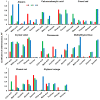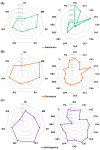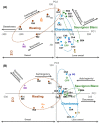Colorimetric Sensor Array for White Wine Tasting
- PMID: 26213946
- PMCID: PMC4570315
- DOI: 10.3390/s150818197
Colorimetric Sensor Array for White Wine Tasting
Abstract
A colorimetric sensor array was developed to characterize and quantify the taste of white wines. A charge-coupled device (CCD) camera captured images of the sensor array from 23 different white wine samples, and the change in the R, G, B color components from the control were analyzed by principal component analysis. Additionally, high performance liquid chromatography (HPLC) was used to analyze the chemical components of each wine sample responsible for its taste. A two-dimensional score plot was created with 23 data points. It revealed clusters created from the same type of grape, and trends of sweetness, sourness, and astringency were mapped. An artificial neural network model was developed to predict the degree of sweetness, sourness, and astringency of the white wines. The coefficients of determination (R2) for the HPLC results and the sweetness, sourness, and astringency were 0.96, 0.95, and 0.83, respectively. This research could provide a simple and low-cost but sensitive taste prediction system, and, by helping consumer selection, will be able to have a positive effect on the wine industry.
Keywords: artificial neural network; colorimetric; principle component analysis; taste sensor.
Figures






Similar articles
-
Taste-guided isolation of sweet-tasting compounds from grape seeds, structural elucidation and identification in wines.Food Chem. 2019 Jan 30;272:388-395. doi: 10.1016/j.foodchem.2018.08.070. Epub 2018 Aug 18. Food Chem. 2019. PMID: 30309559
-
Characterization of taste-active fractions in red wine combining HPLC fractionation, sensory analysis and ultra performance liquid chromatography coupled with mass spectrometry detection.Anal Chim Acta. 2010 Jul 19;673(2):151-9. doi: 10.1016/j.aca.2010.05.038. Epub 2010 Jun 4. Anal Chim Acta. 2010. PMID: 20599029
-
Classification of rice wine according to different marked ages using a novel artificial olfactory technique based on colorimetric sensor array.Food Chem. 2013 Jun 1;138(2-3):1320-4. doi: 10.1016/j.foodchem.2012.11.124. Epub 2012 Dec 5. Food Chem. 2013. PMID: 23411249
-
The mouthfeel of white wine.Crit Rev Food Sci Nutr. 2018;58(17):2939-2956. doi: 10.1080/10408398.2017.1346584. Epub 2017 Aug 22. Crit Rev Food Sci Nutr. 2018. PMID: 28678530 Review.
-
Advanced taste sensors based on artificial lipids with global selectivity to basic taste qualities and high correlation to sensory scores.Sensors (Basel). 2010;10(4):3411-43. doi: 10.3390/s100403411. Epub 2010 Apr 8. Sensors (Basel). 2010. PMID: 22319306 Free PMC article. Review.
Cited by
-
Assessment of Bitterness in Non-Charged Pharmaceuticals with a Taste Sensor: A Study on Substances with Xanthine Scaffold and Allopurinol.Molecules. 2024 May 23;29(11):2452. doi: 10.3390/molecules29112452. Molecules. 2024. PMID: 38893328 Free PMC article.
-
Taste Sensor Assessment of Bitterness in Medicines: Overview and Recent Topics.Sensors (Basel). 2024 Jul 24;24(15):4799. doi: 10.3390/s24154799. Sensors (Basel). 2024. PMID: 39123846 Free PMC article. Review.
-
Identification of the Rice Wines with Different Marked Ages by Electronic Nose Coupled with Smartphone and Cloud Storage Platform.Sensors (Basel). 2017 Oct 31;17(11):2500. doi: 10.3390/s17112500. Sensors (Basel). 2017. PMID: 29088076 Free PMC article.
-
Positively Charged Organosilanes Covalently Linked to the Silica Network as Modulating Tools for the Salinity Correction of pH Values Obtained with Colorimetric Sensor Arrays (CSAs).Sensors (Basel). 2024 Jan 10;24(2):417. doi: 10.3390/s24020417. Sensors (Basel). 2024. PMID: 38257510 Free PMC article.
-
An Electronic "Tongue" Based on Multimode Multidirectional Acoustic Plate Wave Propagation.Sensors (Basel). 2024 Sep 29;24(19):6301. doi: 10.3390/s24196301. Sensors (Basel). 2024. PMID: 39409341 Free PMC article.
References
-
- Bae Y.M., Cho S.I. Use of a polymer membrane sensor array for quantification and discrimination of liquid food. Trans. ASABE. 2005;48:251–256. doi: 10.13031/2013.17925. - DOI
-
- Arrieta A., Rodriguez-Mendez M.L., de Saja J.A. Langmuir–Blodgett film and carbon paste electrodes based on phthalocyanines as sensing units for taste. Sens. Actuators B Chem. 2003;95:357–365. doi: 10.1016/S0925-4005(03)00438-6. - DOI
-
- Winquist F. Voltammetric electronic tongues—Basic principles and applications. Microchim. Acta. 2008;163:3–10. doi: 10.1007/s00604-007-0929-2. - DOI
Publication types
MeSH terms
Substances
LinkOut - more resources
Full Text Sources
Other Literature Sources

